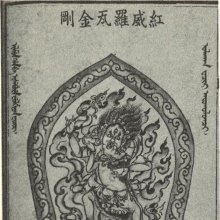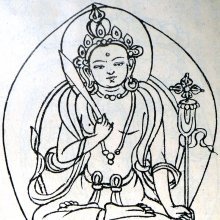Yamari, Yamāri, Yama-ari: 8 definitions
Introduction:
Yamari means something in Buddhism, Pali, Hinduism, Sanskrit, biology, Tamil. If you want to know the exact meaning, history, etymology or English translation of this term then check out the descriptions on this page. Add your comment or reference to a book if you want to contribute to this summary article.
Images (photo gallery)
In Buddhism
Tibetan Buddhism (Vajrayana or tantric Buddhism)
Source: archive.org: The Indian Buddhist Iconography1) Yamāri (यमारि) is another name for Yamāntaka: one of the various emanations of Akṣobhya, as mentioned in the 5th-century Sādhanamālā (a collection of sādhana texts that contain detailed instructions for rituals).—When Yamāntaka is red he is called Raktayamāri and when he is blue he is called Kṛṣṇayamāri. Yamāri or Yamāntaka may either be worshipped alone or in conjunction with his Prajñā. He should have the head of a buffalo on his shoulders and should ride a buffalo.
Yamāri is sometimes seen accompanying Mañjuśrī, as depicted in Buddhist Iconography.—In his simplest form Mañjuśrī carries the sword in his right hand and the Prajñāpāramitā manuscript in his left. In representations sometimes the two symbols are placed on lotuses. Sometimes Mañjuśrī is accompanied only by Yamāri, sometimes only by his Śakti or female counterpart, sometimes by Sudhanakumāra and Yamāri and sometimes again by the four divinities, Jālinīprabha (also called Sūryaprabha), Candraprabha, Keśinī and Upakeśinī. Though the last four are required to be present with Arapacana, they are nevertheless found in others also.
Yamāri of blue colour is the principal deity in the Yamārimaṇḍala of the Niṣpannayogāvalī:—
“Yamāri’s three faces show the blue, white and red colour in the principal, the right and the left. He is six-armed. In the principal pair of hands carrying the kartri and the kapāla he embraces the Prajñā of his own creation. In the two remaining right hands he carries the vajra and the sword, and in the two left he carries the discus and the lotus”.
2) Yamāri (यमारि) is also another name for Yamāntaka: one of the ten deities of the quarters (Dikpāla) presiding over the east, commonly depicted in Buddhist Iconography, and mentioned in the 11th-century Niṣpannayogāvalī of Mahāpaṇḍita Abhayākara.—His Colour is blue; he has six arms and three faces.—Yamāntaka presides over the East and is one of the popular deities of the Buddhist pantheon He is also known as Yamāri who is often endowed with two forms known as Kṛṣṇa-Yamāri and Rakta-Yamāri.

Tibetan Buddhism includes schools such as Nyingma, Kadampa, Kagyu and Gelug. Their primary canon of literature is divided in two broad categories: The Kangyur, which consists of Buddha’s words, and the Tengyur, which includes commentaries from various sources. Esotericism and tantra techniques (vajrayāna) are collected indepently.
Biology (plants and animals)
Source: Wisdom Library: Local Names of Plants and DrugsYamari [യമരി] in the Malayalam language is the name of a plant identified with Chassalia curviflora var. ophioxyloides (Wall.) Deb & B.Krishna from the Rubiaceae (Coffee) family having the following synonyms: Chassalia ophioxyloides, Chassalia ambigua, Psychotria ophioxyloides. For the possible medicinal usage of yamari, you can check this page for potential sources and references, although be aware that any some or none of the side-effects may not be mentioned here, wether they be harmful or beneficial to health.

This sections includes definitions from the five kingdoms of living things: Animals, Plants, Fungi, Protists and Monera. It will include both the official binomial nomenclature (scientific names usually in Latin) as well as regional spellings and variants.
Languages of India and abroad
Sanskrit dictionary
Source: DDSA: The practical Sanskrit-English dictionaryYamāri (यमारि).—&c. Name of Viṣṇu.
Derivable forms: yamāriḥ (यमारिः).
Yamāri is a Sanskrit compound consisting of the terms yama and ari (अरि). See also (synonyms): yamaghna, yamaripu.
Source: Cologne Digital Sanskrit Dictionaries: Edgerton Buddhist Hybrid Sanskrit DictionaryYamāri (यमारि).—= prec.: Sādhanamālā 95.19 etc. This suggests that the prec. came to be interpreted as destroyer of Yama.
Source: Cologne Digital Sanskrit Dictionaries: Monier-Williams Sanskrit-English DictionaryYamāri (यमारि):—[from yama > yam] m. ‘Y°’s enemy’, Name of Viṣṇu, [Pañcarātra]
[Sanskrit to German]
Sanskrit, also spelled संस्कृतम् (saṃskṛtam), is an ancient language of India commonly seen as the grandmother of the Indo-European language family (even English!). Closely allied with Prakrit and Pali, Sanskrit is more exhaustive in both grammar and terms and has the most extensive collection of literature in the world, greatly surpassing its sister-languages Greek and Latin.
Tamil dictionary
Source: DDSA: University of Madras: Tamil LexiconYamāri (யமாரி) noun < Yamāri. Śiva, as Yama's foe; [யமனுக்குப் பகைவன்] சிவபிரான். [[yamanukkup pagaivan] sivapiran.]
Tamil is an ancient language of India from the Dravidian family spoken by roughly 250 million people mainly in southern India and Sri Lanka.
See also (Relevant definitions)
Starts with: Yamaripu.
Ends with: Kayamari, Krishnayamari, Mayamari, Nilayamari, Periyamari, Raktayamari.
Full-text: Vajradanda, Yamaghna, Yamaripu, Suryaprabha, Upakeshini, Kesini, Sudhanakumara, Krishnayamari, Yamantaka, Raktayamari, Manjushri, Jaliniprabha, Candraprabha.
Relevant text
Search found 5 books and stories containing Yamari, Yamāri, Yama-ari, Yamaari; (plurals include: Yamaris, Yamāris, aris, Yamaaris). You can also click to the full overview containing English textual excerpts. Below are direct links for the most relevant articles:
Reverberations of Dharmakirti’s Philosophy (by Birgit Kellner)
On Pramāṇabhūta (i.e., pramāṇa and bhūta)
The Indian Buddhist Iconography (by Benoytosh Bhattachacharyya)
Blue Annals (deb-ther sngon-po) (by George N. Roerich)
Chapter 4 - Pramāṇavārtika lineages < [Book 6 - The Origin of the Mādhyamika (middle way)]
Chapter 13 - Staglungpa (viii): Ratna guru < [Book 8 - The famous Dakpo Kagyü (traditions)]
Chapter 10 - Phagmodru Lineage (iv): gcung bcu gnyis pa < [Book 8 - The famous Dakpo Kagyü (traditions)]
The gods of northern Buddhism (by Alice Getty)
Guhyagarbha Tantra (with Commentary) (by Gyurme Dorje)
Text 3.18 (Commentary) < [Chapter 3 (text and commentary)]
Related products


